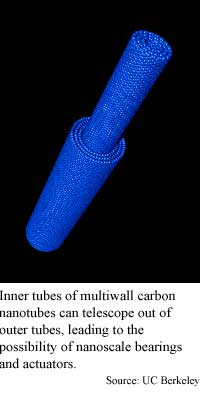
Nanotubes make microscopic bearings
By Eric Smalley, Technology Research NewsResearchers at the University of California at Berkeley have opened the ends of multiwall carbon nanotubes, which are tiny nested tubes as small as one nanometer in diameter, and they have slid smaller nanotubes in and out of larger nanotubes.
The ability to telescope nanotubes opens up the possibility for manufacturing bearings and actuators hundreds of thousands of times smaller than a millimeter. These microscopic bearings and actuators could be used to build nanoscale machines and motors.
"We figured out a way to electrically peel away the ends of a nanotube in a relatively careful and controlled way. [It's] a way to sharpen a tube, just like sticking a pencil in a pencil sharpener," said Alex Zettl, a professor of physics at UC Berkeley and senior scientist at Lawrence Berkeley National Laboratory. "As a bonus... we had access to different concentric layers of the multiwall nanotube."
Zettl and graduate student John Cumings used a transmission electron microscope to grasp an inner tube of an opened multiwall nanotube and slide it out of an outer tube. When the inner tube was released it was drawn back inside the outer tube by the van der Waals force, which is the force of attraction between atoms.
"Carbon nanotubes have been computationally recognized as nanoscale equivalents of macroscopic machine components, such as gears and bearings," said Jie Han, a research scientist at the NASA Ames Research Center and author of a paper proposing nanotube-based gears. Cumings and Zettl's work, "for the first time experimentally demonstrated the feasibility of making nanotube based molecular machines," he said.
Though nanomachines will likely resemble macroscopic machines in form and function, the individual molecules that will make up nanomachines behave differently than the large volumes of molecules that make up macroscopic machines.
Cumings and Zettl's work "shows the important difference in operational modes between future nanoscale molecular machines and their macroscopic cousins," Han said. "Deformation and resultant fatigue failures caused by small strains in macroscopic structures won't occur in nanomachines where atomic precision ensures that structural defects do not exist," he said. Also, any changes in shape at this scale are temporary, said Han
"In addition, there is no surface wear and no need for lubricants in atomically precise nanostructures," he said.
However, nanomachines could be affected by subatomic particles and radiation, Han said, noting that further research is needed to determine this.
The potential of multiwall nanotubes to serve as bearings and actuators portends entire machines no larger than a handful of molecules. Combining Zettl's nanotube bearings with the work of nanotube pioneer Richard Smalley of Rice University, who has attached a wide range of molecules to nanotubes, will lead to "functional nanoscale machinery parts and molecular machines sooner or later," Han said. It's likely that nanotube bearings will first be used as components of larger devices.
"We hope to use our nanoscale bearings and actuators integrated into larger devices that are useful in force sensing and chemical sensing and all kinds of things," said Zettl. "The first application would be to try to integrate these with MEMS devices that already exist."
MicroElectroMechanical Systems (MEMS), tiny machines ranging from several to hundreds of microns in size, have been prone to wear and failure because the effects of forces like friction are amplified at that scale. Nanotube components could overcome some of those problems, Zettl said.
Another potential use for telescoping multiwall nanotubes is as electromechanical switches, Zettl said. The switches could be used for memory or logic units in computers.
"It turns out when you go to this nanoscale electromechanical things are very fast... and [they can] compete with electronics," he said.
Cumings and Zettl published their work in the July 28 issue of the journal Science. The research was funded by the Department of Energy.
Timeline: Unknown
Funding: Government
TRN Categories: Nanotechnology
Story Type: News
Related Elements: Photo, Graphic, Technical paper "Low-Friction Nanoscale Linear Bearing Realized from Multiwall Carbon Nanotubes" in Science July 28, 2000
Advertisements:
September 13, 2000
Page One
Cheap lasers on the way
Nanotubes make microscopic bearings
Integrated inputs improve interactivity
Microorganisms infect computer chips
Sandia brews cheap telecom laser

News:
Research News Roundup
Research Watch blog
Features:
View from the High Ground Q&A
How It Works
RSS Feeds:
News
Ad links:
Buy an ad link
| Advertisements:
|
 |
Ad links: Clear History
Buy an ad link
|
TRN
Newswire and Headline Feeds for Web sites
|
© Copyright Technology Research News, LLC 2000-2006. All rights reserved.